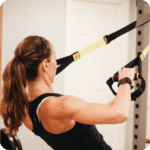TRX Suspension Training is great for those who want to develop lean muscle, build muscle, or lose weight.
 Have you ever noticed yellow and black straps hanging from under the balcony at the Plum Street Y? They are called Suspension Trainers (no, they have nothing to do with aerial yoga!). Suspension training provides a unique method of bodyweight training for strength and general fitness, as well as sports performance.
Have you ever noticed yellow and black straps hanging from under the balcony at the Plum Street Y? They are called Suspension Trainers (no, they have nothing to do with aerial yoga!). Suspension training provides a unique method of bodyweight training for strength and general fitness, as well as sports performance.
The straps were invented by Randy Hetrick, a Navy SEAL who found himself needing to stay in peak condition when missions took him away from home base and the usual fitness equipment and often gave him only limited space. The answer to this dilemma was a set of straps that could be easily carried in a bag, set up anywhere, and provide a range of functional exercise movements while allowing adjustments for different strength and fitness levels.
The success of Suspension Training led to the founding of the TRX (Total Resistance Exercise) company, and the wider distribution of the Suspension Trainer. Today, the Suspension Trainer is not only embraced by personal trainers, physical therapists, sports medicine clinics, chiropractic offices and pilates studios, it is also used in senior wellness programs because it allows seniors to move with less fear of falling (although it does require a certain amount of grip strength).
Working on the Suspension Trainer works skills required not only in sports, but in the activities of daily living, and exercises can run the gamut from easy beginner level, to extremely advanced. By working often in multiple planes of motion, simultaneously using strength, flexibility, balance and core stability, the Suspension Trainer works the body as an integrated system. And, it’s all core, all the time — almost every exercise is a moving plank.
Generally, the user has one or both hands, or one or both feet, in the straps, while the opposite end of the body is in contact with the floor. Adjusting resistance requires moving toward, or away from, the point where the Suspension Trainer is attached to a stationery object, be it a post, or a tree — or even a balcony. This single-point attachment allows both support and mobility in a wide range of directions and resistance.
As with any fitness equipment or tool, there are principles and rules that will affect both its safety and effectiveness:
- No sagging — the straps should always remain taught (never loose) throughout the exercise or movement.
- No rubbing — the straps should ever rub against the body. You want your body to provide the stabilization, not the straps.
- No sawing — the straps have a loop that allows one handle to lengthen more than the other. To prevent this, the pressure should be kept equal on both straps (again, stabilization!).
Would you like to learn more about how to work out with the Suspension Trainer? Look for the upcoming new TRX Suspension Training Basics class at 5:30 PM on Tuesdays at the Plum Street Y. Be prepared for a totally different kind of workout!

